Q&A – Ask Neil: March 9, 2023
(Please read these instructions carefully.)
Before you post your question, please look at recent issues to see if someone else has already asked it. You might find your answer there.
How to submit your question…
• Click the link provided below to post your question. After you submit your question, a new window will pop up giving you the address to which you can e-mail a photo to accompany your question. Clear, medium-resolution photos. (Try to avoid low-res thumbnail photos, please, in case I have to zoom in to see things.)
• Click here to post your question.
• Please only post your question one time.
• One question per reader, please.
• Please use this only for posting questions – not for standard emails.
• Watch for your answer in the following week’s e-gardens.
• I choose those of greatest general interest. For example, plant IDs seldom make the cut.
• I must have your first name or initials.
• I must have your city or county. (Texas is a very large state.)
QUESTION 1
DO I NEED TO TREAT FOR CRAPE MYRTLE BARK SCALE AGAIN THIS YEAR?
Question: I had severe bark scale on my crape myrtles in 2021. I applied the soil drench in early May 2022 and they came back beautifully. Do I need to do it again this year, or is the scale gone for good? T.N., Parker.
Answer: I know the Imidacloprid soil drench applied around mid-May gets a wee bit pricey, but since you had scale so recently, I would definitely treat again this May. Scales do move around in a neighborhood, so it’s not worth the chance. It’s great to hear that the drench did the job!
QUESTION 2
WHY WOULD THE HOLLY ON THE LEFT BE LIGHTER GREEN AND HAVE FEWER LEAVES?
Question: I know these bushes are a holly, but I don’t know which one. They were both planted in March 2016. The one on the left has always struggled. It hasn’t grown as much and has always been sparse of leaves. What might be causing those problems? Karen G., Sherman.
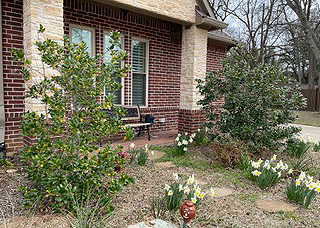
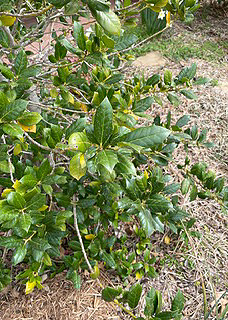
Answer: Having grown probably 150 hollies of 35 different varieties in our rural Collin County landscape (for folks in other parts of Texas, that’s the next county south of Karen) for the past 46 years, I can take an educated guess as to why there is a difference. It’s one of two things. The plant on the left has had an ongoing shortage of water or nitrogen. Since you say that it never looked as good, my bet would be that it got too dry sometime in its first year in your landscape. You may not even have noticed it. Hollies don’t wilt to give us a warning. I’ll bet it got precariously near the point of no return and that it has struggled ever since. Try giving it a water-soluble, very high-nitrogen fertilizer this growing season, and keep it very moist at all times – not sopping wet, but certainly never dry. See if you can’t pull it back to vigorous growth.
QUESTION 3
HOW CAN WE FIND A PROFESSIONAL TO HELP WITH HOLISTIC RECOMMENDATIONS FOR TREES, GRASS, FERTILIZER, SOD, ETC.?
Question: We’re new owners of a lot with grass with an abundance of trees, therefore shade. Prior owners didn’t care for it properly. How can we find a professional to help with holistic recommendations for trees, grass, fertilizer, sod, etc.? Rich K., Fort Worth.
Answer: I would look for a person who has years of experience in urban horticulture. Start with a Texas Master Certified Nursery Professional. That person will have studied long and hard hours to pass difficult exams proving their knowledge of all things pertaining to urban horticulture. They are at member nurseries of the Texas Nursery and Landscape Association. A really skilled landscape contractor could do the work for you, and the TNLA has a certification program for them as well. Your Tarrant County Extension office would have good help, as would the Extension Horticulture website from College Station. My book Lone Star Gardening covers almost anything you could want to know about. You’ll find links to buy it here in e-gardens. (It’s not in stores or on Amazon.) I always promise that I’ll refund your purchase if you feel it misses your mark (although no one has ever requested a refund with 77,000 sold to date).
QUESTION 4
WILL THIS CADDO PECAN EVER BE GOOD?
Question: We planted this Caddo pecan tree seven years ago. We pruned it and watered it according to instructions, but it has not done nearly as well as the others. It was 5 feet tall when planted. I’m concerned it will always have this curve because of a graft in it. Should we give up and dig it up? Pam B., Rockwall.
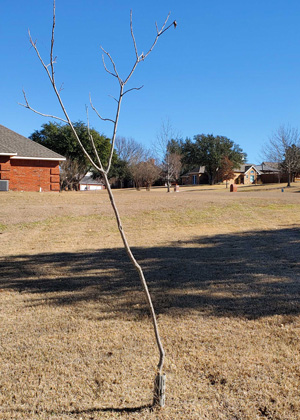
Answer: The graft is down near the ground line, probably just above the trunk guard. If this were my tree (knowing what a good variety Caddo is), I would give it one more chance. I would prune it way back, perhaps just a foot or so above the trunk guard. Then I would apply a fast-release, all-nitrogen fertilizer about 15-18 inches out from the trunk all the way around. Ammonium sulfate (21-0-0) would be ideal (one pound per inch of trunk diameter per time). Apply it April 1, May 1, and June 1, and water deeply after each application. Your goal will be to stimulate vigorous growth this spring and summer. You can select and train the straightest, strongest single trunk that grows out from the trunk that remains. Keep it very moist all through the growing season. Parts of Rockwall County have very shallow soil, and it’s possible this is growing on a white rock outcropping. If so, that’s going to necessitate frequent watering and feeding. Good luck with it!
QUESTION 5
IS IT TIME FOR WEEKLY FERTILIZING OF POTTED PLANTS?
Question: Should I begin weekly fertilizing of new potted plants and ones that survived the December freeze? Cindy P., San Antonio.
Answer: Yes. We’re well into the growing season now, especially as far south as you are in San Antonio. Use a high-nitrogen, water-soluble food with a trace elements package included each time that you water.
QUESTION 6
WHAT IS A GOOD AND REASONABLY PRICED ALL-NITROGEN FERTILIZER TO REJUVENATE MY BROWN ASIAN JASMINE?
Question: My Asian jasmine looks terrible. What is a good and reasonably priced all-nitrogen fertilizer to rejuvenate it this spring? David P., Cibolo, Guadalupe Co.
Answer: If you shop at several nurseries, hardware stores and feed stores, you will find many. I’ve always made it my practice not to promote brands in my answers, even when I have sponsors with very good products that would be perfect fits (which I do in this case). You want to look at the first number of the three-number analysis. That’s nitrogen, and that’s the one you want to be very high in relation to the other two (phosphorus and potassium respectively). Then you want to look for a brand that has 30-40 percent, perhaps even half of that nitrogen in slow-release form. Slow-release nitrogen will be marked as “encapsulated” or “coated.”
That will let you do rough cost comparisons. The nitrogen number will be percentage of content that is nitrogen. You’ll be able to multiply that percentage times the total weight of the bag to get the total pounds of nitrogen in the bag. Divide that into the cost to determine how much you’ll be paying per pound. It’s all very rough math, but it will put you in the ballpark. You don’t want or need other additives like insecticides and weedkillers.
QUESTION 7
DO PEACH TREE BORERS REMAIN IN THE SOIL 10 YEARS AFTER I REMOVED DEAD TREES?
Question: Borers killed our peach trees 10 years ago. Are the worms forever in our yard, or can preventive maintenance lead to success? Michael K., New Braunfels.
Answer: You can certainly try again. The adult moths moved on to other yards and other neighborhoods the year after you removed their food source 10 years ago. Peach tree borers are extremely damaging to all the stone fruit crops, most notably peaches and plums here in Texas. And, when Dursban (Lorsban) was taken off the consumer market, it made it much more difficult for us to find specific home gardener product recommendations. I just spent 45 minutes online seeing if there was anything current that might be helpful, and these are what I found:
From the University of Kentucky, a really good write up with photos of the adult moths. However, their preventive measures tend to be for commercial orchards. Nonetheless, there is great information here.
https://entomology.ca.uky.edu/ef200
Colorado State University has an excellent fact sheet with outstanding photos and information. The only thing wrong with it is the timing. Because of their colder climate and shorter growing season their application dates are much earlier than you would want in New Braunfels (or almost anywhere in Texas). Treatment time is more likely to be early and late August.
https://extension.colostate.edu/topic-areas/insects/peach-tree-borer-5-566/ They mention that certain formulations of permethrin and carbaryl (Sevin) are the only products that can be recommended in Colorado. I assume that would be true in Texas as well.
The University of Missouri’s information covers many types of borers, but if you scroll down you’ll find the peachtree borers. This sheet offers backup information to the others I’ve listed.
https://extension.missouri.edu/publications/g7190
QUESTION 8
WHAT IS ATTACKING MY HOLLIES, CUTTING OFF LEAVES WITHOUT ANY EVIDENCE.
Question: What is attacking my hollies? These are new plantings from last spring, not the established ones. It looks like the leaves were cut off with no remains left on the ground. Carol V., Collin Co.

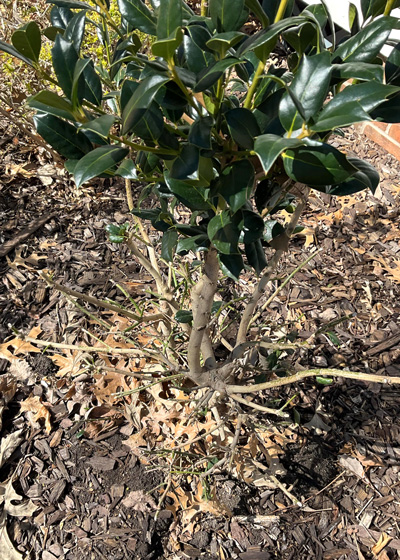
Answer: Our son and his family live in a large development on the west side of McKinney. I helped them re-landscape their home after the freeze of February 2021, and much to my amazement, rabbits did this exact damage to their new plants – even to the leathery, mature foliage. That would be my guess in your situation. They had to put a temporary chicken wire fence around their plants until they could get established. There is no good repellent that lasts longer than the next rainstorm or irrigation.
QUESTION 9
WHAT SHOULD I DO WITH MY DWARF MONDOGRASS?
Question: I’m accustomed to mowing and trimming my liriope and regular mondograss when it turns brown, but what do I do with dwarf mondograss that looks like this? It’s too short to mow or trim. Brent F., McKinney.
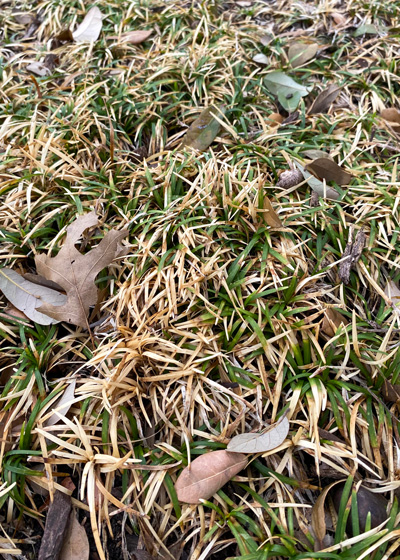
Answer: My wife and I live just outside McKinney and mine looks just like yours does. As does our regular mondograss. I’ve decided to leave all of mine alone. In fact, in anticipation of a little bit of rain this week, we applied a high-nitrogen lawn food to all our groundcover beds just two days ago to encourage quick green-up as the weather warms up. I was just looking at it all a couple of hours ago before I typed up these answers, and green new growth is just starting to emerge. (Folks in South Texas are thinking we’re really behind the times.) You may have a few plants to replace, however.
